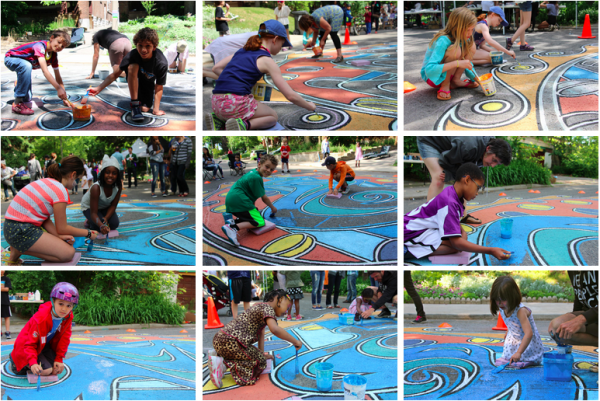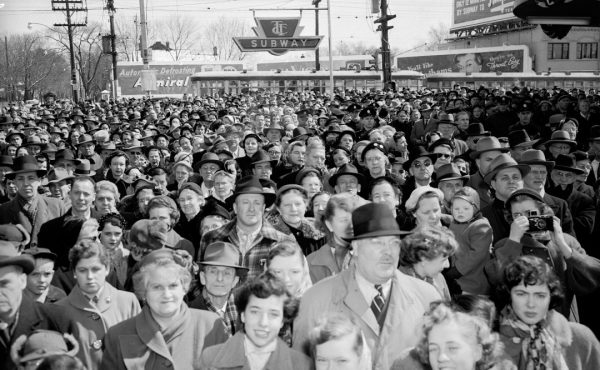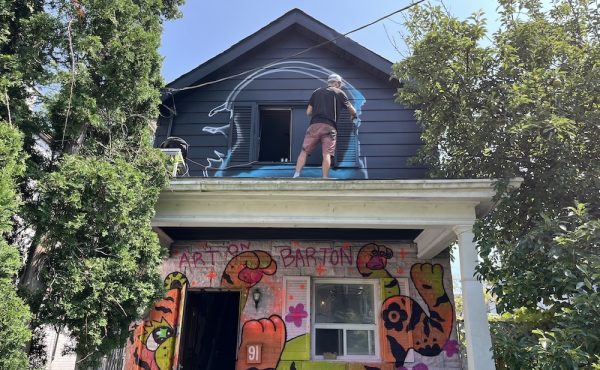It’s been seven months since I wrote about the Regal Heights street mural, a community-driven art project painted by neighbours of all ages on Springmount Avenue.
Despite half a year of rain, traffic and salt, the mural is still looking pretty good, although the brightness of the colours has already begun to slowly fade. That’s the nature of street murals. Daily abuse ensures that they don’t last as long as their vertical cousins painted on walls. That’s part of the fun: re-painting the mural, with a new design, every few years! Luckily, this particular community art project has been immortalised on Street View. But while Google has given the Regal Heights street mural eternal digital life, it looks like City staff are trying to ensure that the project itself has no future at all.
In response to a supportive motion from Councillor Cesar Palacio, Transportation Services has written a stunning staff report, recommending that no street murals be allowed anywhere in Toronto. The same report acknowledges that painted street murals are currently allowed in Vancouver, Ottawa, Halifax and Kitchener.
City staff in Vancouver say that street murals “enhance public spaces and create opportunities for neighbours and diverse members to form relationships, elevate community pride, and participate in the process, including planning, meetings, workshops, work parties and painting.”
Ottawa staff claim that street murals provide “a way to connect and inspire students and community volunteers through creating art to beautify public space“.
In Halifax, “Municipal staff provide support to seek necessary approvals and works collaboratively with community members to design accessible, creative and successful project plans. If the project is a street mural, the municipality also provides staff support for project painting days.”
Meanwhile, in Toronto,“City staff have investigated these projects in other cities, reviewed potential requirements in the City of Toronto, and do not recommend pursuing a new Street Mural program at this time.”
Why does Toronto do this so often? How have we allowed such a risk-averse culture to consume our bureaucracy? While other cities innovate, we come up with excuses not to do something.
Don’t get me wrong. I have a lot of empathy for our City staff. They are often overworked and under-resourced. I understand their reluctance to take on large new projects, while council refuses to allocate and collect the funds required to build a great city. But this project is exactly the kind of proposal that staff should love. It’s small, volunteer-driven, and cheap. Neighbours have to create their own artwork, build local support, pay for the supplies, and coordinate the painting. Yes, the City will have to provide a “street closure” permit… but they already have a system in place for that. And yes, the City will have to approve the design… but they already do that as well, for wall murals. There are pre-existing processes for all of these details.
Ottawa staff have reported a reduction in car speeds, that there have been “no incidents or safety concerns” and that the murals are “very popular with the community and the media“. If other cities with MUCH smaller budgets have been able to do this, then why can’t we? It makes no sense at all.
The Public Works and Infrastructure Committee will be debating and voting on the staff report on Thursday January 21st. Here are two ways you can make a difference:
- Send a short e-mail to the Committee. Let them know why you support street murals! Put the item number “PW10.1” in your subject line, and send to: pwic@toronto.ca, councillor_robinson@toronto.ca, councillor_holyday@toronto.ca, councillor_lee@toronto.ca, councillor_mcmahon@toronto.ca, councillor_moeser@toronto.ca, councillor_perruzza@toronto.ca
- Attend the meeting and make a short deputation to the Committee members. Any member of the public is allowed to speak to the Committee, for up to five minutes. It’s very powerful when members of the community take the time to attend a meeting and speak. The meeting is next Thursday, 9:30am, at City Hall. To register, send an e-mail to the clerk: pwic@toronto.ca
If enough people write, hopefully it will convince the Committee to reject the staff recommendation and allow more neighbourhoods to beautify their pavement.
The Regal Heights street mural will eventually fade away. Hopefully, by the time it does, there will be many new murals across the city, painted by neighbours who care enough about their community to contribute some time, energy and creativity towards a collective act of beautification.





4 comments
Toronto embraces art in public places. No other city in Canada does as much.
City of Toronto link: http://www1.toronto.ca/wps/portal/contentonly?vgnextoid=bebb4074781e1410VgnVCM10000071d60f89RCRD
This project was a wonderful free project for our Community in Regal,Heights. Voting against more such projects is hard to understand. Maybe the Committee thinks we are having too much fun.
To vote against a positive project like a street mural is baffling. Does the Committee think we are having too much fun?
The disconnect here seems to be the fact that the community sees this as a small local project that is essentially independent of city staff, whereas staff see it as a bundle of new, un-financed responsibilities. The report talks about the need to regulate and monitor the murals, including “a multi-step application process…community consultation…ensuring the artwork is appropriate for a neighbourhood and of high artistic integrity…a 12-month traffic monitoring program etc.”
This issue vexes all sorts of public space initiatives, from small park improvements to bike lane installation. Once it is seen to fall under the city’s responsibility it is perceived to trigger a mass of regulations that are not appropriate to the scale of the intervention. These things can be resolved, but it takes direction from council and then some work on the part of staff and the community to create, or connect to a more appropriate structure.
For example, do staff really need to take responsibility for ensuring that a design is appropriate for the neighbourhood? Or is it enough to require that residents confirm that they have undertaken certain requirements of a public process (a neighbourhood meeting, flyers in mailboxes, enough time for people to object to the design) and to ensure that there is nothing obviously offensive (e.g. racist symbols, curse words). Do staff have to do a year of traffic monitoring, or is it enough to restrict the program to low traffic neighbourhood streets and then respond to complaints if any arise? I’m not sure what kind of mural design would create a traffic safety hazard, but if there are specific issues, staff can articulate these and let communities know that they are not permitted.
A lot of these things are similar to processes already in place for things like local street parties.
The point is that processes can be put in place that are not overly onerous on the community or staff, but it does require direction from council, and some front end setup work by interested citizens and staff.